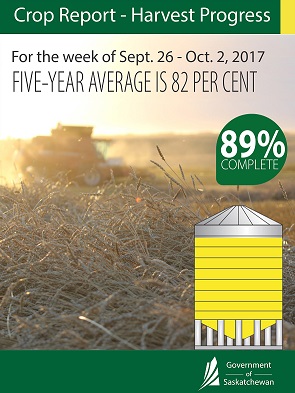Released on October 5, 2017
Warm and dry weather earlier in the week allowed many producers to return to the field after several days of rain delays. Eighty-nine per cent of the crop is now in the bin, up from 78 per cent last week. Harvest progress remains ahead of the five year (2012-2016) average of 82 per cent for this time of year. Eight per cent of the crop is swathed or ready to straight-cut.
Harvest is most advanced in the southwestern region, where 98 per cent of the crop is now combined. The southeastern and west-central regions have 92 per cent combined and the east-central region 89 per cent. The northeastern region has 78 per cent combined, while the northwestern region has 69 per cent combined.
Many producers worked long hours over the last week to combine remaining crops prior to the rain. Some crops have been taken off tough and placed into aeration bins.
Ninety-nine per cent of chickpeas, 98 per cent of mustard, 97 per cent of durum, 93 per cent of canaryseed, 92 per cent of spring wheat and barley, 84 per cent of canola, 81 per cent of oats, 64 per cent of flax and 46 per cent of soybeans have now been combined. Fourteen per cent of canola is swathed or ready to straight-cut.

Producers in many areas of the province welcomed the heavy rain and snow to help replenish the topsoil. However, warm and dry weather is now needed for producers to finish harvest. Rainfall this past week ranged from small amounts to 92 mm in the Kenaston area. Many central and northeastern areas reported well over 50 mm of rainfall, while areas in the south reported snow.
Topsoil moisture conditions have greatly improved with the recent moisture, but more will be needed to replenish the subsoil moisture for next spring. Across the province, topsoil moisture on cropland is rated as five per cent surplus, 39 per cent adequate, 43 per cent short and 13 per cent very short. Hay land and pasture topsoil moisture is rated as two per cent surplus, 34 per cent adequate, 39 per cent short and 25 per cent very short.
Yield estimates remain about average overall, although they vary greatly across the province depending on time of seeding and moisture received throughout the season. Some eastern and northern areas are reporting higher-than-average yields, thanks to timely rainfall. Yields in much of the southern and central regions were greatly affected by the extended period of hot and dry conditions this summer. Many crops did not fill properly as they ran out of moisture much earlier than normal. Some cereal crops have reduced protein content and lighter bushel weights. Spring wheat grades are above the 10 year average and are being reported as 74 per cent 1 CW, 23 per cent 2 CW and three per cent 3 CW.
The majority of crop damage this past week was due to localized flooding, frost, strong winds, lack of moisture and wildlife such as geese and deer.
Producers are busy combining, completing fall field work, moving cattle and hauling bales.
SaskPower received five reports last week of farm machinery coming in contact with electrical equipment, bringing the total for September to 28. Producers are urged to be especially careful when using equipment around power lines. Safety information is available at www.saskpower.com/safety.
For a copy of the crop report, visit http://www.publications.gov.sk.ca/redirect.cfm?p=87509&i=104171.
Follow the 2017 Crop Report on Twitter at @SKAgriculture.
-30-
For more information, contact:
Shannon Friesen
Agriculture
Moose Jaw
Phone: 306-694-3592
Email: shannon.friesen@gov.sk.ca

